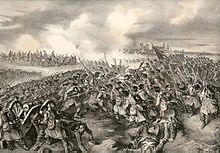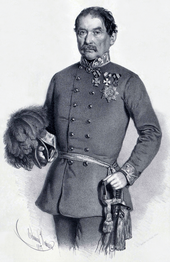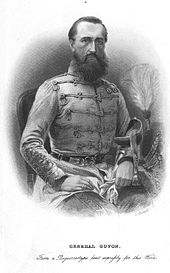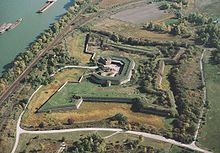First battle near Komorn
Pákozd - Schwechat - Košice - Mór - Piski - Mediasch - Kápolna - Hatvan - Tápió Bicske - Isaszeg - Waitzen I - Nagy-Salló - Komorn I - Mocsa - Kács - Pered - Raab - Ács (Komorn II) - Komorn III - Hegyes - Waitzen II - Tura - Sighișoara - Debreczin - Szöreg - Temesvár
Arad - Deva - Esseg - Karlsburg - Komorn - Leopoldov - Oven - Peterwardein - Temesvár
The First Battle of Komorn took place on April 26, 1849 and was part of the Hungarian War of Independence . Up to 24,000 Hungarians who attacked from the north bank of the Danube fought against around 29,000 Austrians in the fortified southern area of the fortress Komorn . The troops involved consisted of the Corps Damjanich (III.), Klapka (I.) and the division Károly Knezich , which formed at dawn on the southern bank of the Danube. With the Hungarians, General Klapka fought on the left wing near Uj-Szőny, in the middle commanded General Damjanich , while the commander-in-chief Arthur Görgey demonstrated the right wing on Ács . The Hungarian army pushed the imperial from the fort Csillagerőd, the previous threat to the fortress Komorn by the imperial was lifted. The Austrians withdrew behind the Waag line and back to Pressburg by April 27th .
prehistory
In the first phase of the spring campaign, General Görgey was able to push back the imperial troops under Field Marshal Prince Windisch-Grätz from the area east of the Hungarian capital Pest across the Danube after the victory in the Battle of Isaszeg (April 6, 1849) .
For the second phase, which was initiated on April 7th, Görgey developed a new plan of attack. Accordingly, the Hungarian army was divided into two groups: General Lajos Aulich advanced with the Hungarian 2nd Corps before Pest, where Colonel Asbóth's division demonstrated as the vanguard. This diverted the attention of the imperial from the north, where the actual attack of the Hungarians with the 1st, 3rd and 7th Corps was to be set up. The advance was to take place along the northern bank of the Danube to Komorn, the siege of which was to be lifted by the imperial forces. The Kmety division of the 7th Corps was initially supposed to cover the advance of the 3rd Corps, which had occupied Waitzen . Thereafter, this division was supposed to secure this city, while the rest of the troops, together with the other two divisions of the 7th Corps , were to advance along the Hron River, then swivel south in order to free the northern apron of the Komorn Fortress from the imperial ones. The plan was risky, because if Prince von Windisch-Grätz had immediately recognized that only one Hungarian corps was facing the plague, he would have attacked Aulich's troops and thereby threatened the lines of communication of the Hungarian main army to Debreczen , where the Hungarian parliament was located. In order to ensure the success of the Hungarian army in front of Komorn, the National Defense Committee from Debreczen sent the required delivery of around 100 wagons with ammunition. In the Battle of Waitzen on April 9, the Hungarian 3rd Corps (General Damjanich) defeated the Austrian Ramberg division , with General Götz fatally injured.
Because of his failures in the second phase of the spring campaign, Prince Windisch-Grätz was recalled by Emperor Franz Joseph on April 12 and replaced by Feldzeugmeister Ludwig von Welden , the previous military governor of Vienna. By the time Welden had arrived, Prince Windisch-Grätz had handed over the high command to the Banus Jellačić as interim commander in Hungary. However, this change in the leadership of the imperial armed forces did not immediately bring the necessary clarity and organization. When Windisch-Grätz finally recognized the opposing intentions, he wanted to launch an attack on Aulich in Pest on April 14, then cross the Danube at Esztergom and threaten the retreat of the main Hungarian army. Field Marshal Lieutenant Franz von Schlick and General Josip Jellacic rejected the risky operation in memory of their failure at Isaszeg ; the plan to cut off communications with the main Hungarian army was not carried out.

In response to the April Laws and the Hungarian constitution, which was repealed in Olomouc on March 4, Hungary declared its complete independence from the Habsburg Empire on April 14, 1849 . As a result of this declaration, a new Hungarian government was installed under Bertalan Szemere , in which Görgey was appointed Minister of War .
The fortress of Komorn was already surrounded by the imperial troops in January 1849 and the systematic siege began in March. The troops of FML Simunich crossed the left bank of the Danube and also threatened Komorn on the northern bank. General Görgey ordered the 3rd Corps under Damjanich to advance in the direction of Léva on April 11th , and to follow the 1st Corps on April 12th. The occupation in Vác was occupied by the 7th Corps (General Gáspár ) until Waitzen was occupied by the Kmety division. Between April 15 and 17, the Hungarian Army, consisting of the 1st and 3rd Corps and two divisions of the 7th Corps, reached the Hron River. On April 19, they met at the Battle of Nagy-Salló with the troops of FML Ludwig von Wohlgemuth , reinforced with the Jablonowski division. The imperial ones were defeated and withdrew towards Érsekújvár . The fortress town Komorn on the northern bank of the Danube, which had been surrounded by the imperial since December 1848, was occupied by the Hungarians on April 22nd. After the victory of Nagy-Sallo , Görgey had the 1st and 3rd Corps cross the Zitava and moved out of the Waag bridgehead into Komorn, while the 7th Corps secured the river to the north and the ridge of the main arm. The next day, Welden ordered the evacuation of Pest but left a sizable garrison in the Buda fortress to defend it against the Hungarian attack. Instead of uniting his troops in front of Buda (Ofen) as planned, Welden had to order the withdrawal and rearrange himself behind the Waag section.
When the commander of the siege troops in front of Komorn, Balthasar von Simunich , learned of the approach of the Hungarians on the morning of April 20, he had to withdraw his Komorn siege corps to the left bank of the Danube to protect the connections to Vienna and Pozsony from being surrounded by Hungary. The Banus Jellačić received orders to stay a while longer in Pest and then to retreat to Esseg in the Bácska , where he was to unite with the allied Serbian armed forces, which were in a serious situation after the victories of the Hungarian armies led by Mór Perczel found.
Situation and attack planning with the Hungarians
On April 20, the Hungarian 7th Corps arrived at Kéménd, where it met a brigade of the Imperial II Corps, which was approaching from Párkány and was led by Major General Franz Wyss . The Austrians were forced to withdraw to Gran, General András Gáspár refrained from being pursued by his cavalry. The following day the Hungarian 1st and 3rd Corps marched towards Komorn and on April 22nd lifted the blockade around the fortress on the northern section. On the same day the Hungarian garrison of Komorn broke out of the defensive line over Nádor and established the connection after the opposing brigade Sossay near Csallóköz had been ousted . The imperial had to retreat to Csallóközaranyos and later to Nyárasd and lost 50 men and 30 horses. FML Wohlgemuth, who had withdrawn his troops west of the Waag River after his defeat at Nagy-Salló, now advanced again to the east in the direction of Érsekújvár , where Görgey threw the 7th Corps to take up a defensive position at Perbete .
On April 21, General Simunich reported to the commander of the II Corps, FML Anton Csorich , that Görgey had penetrated Komorn on that day and that an attack on the south bank of the Danube was imminent. He asked Csorich to send him cavalry and artillery reinforcements. On April 24th he informed Csorich that the Hungarians had made the bridge over the Danube usable again and intended to cross the river on rafts. He asked Csorich to arrive with his troops at Puszta Harkály by the morning of April 25 at the latest to support him against the Hungarian attack.
According to the orders of Feldzeugmeister von Welden, the imperial troops ended the evacuation of Pest on April 23rd, after which General Lajos Aulich and the Hungarian 2nd Corps entered the city on April 25th. Welden ordered Major General Franz Wyss to move his brigade to Tata , Major General von Colloredo to withdraw from Esztergom (Gran) to Dorog and the Schwarzenberg division to follow from Buda to Gran in order to assemble all Austrian troops on the upper Danube Bend as far as Komorn.
General Görgei ordered the Hungarians to cross the Danube in order to attack the Austrians who were concentrated there and to force victory with his numerical superiority. Görgey, who was able to use his earlier studies, planned the transition between the castle of Komorn and the bridgehead on the southern bank at the fortress of Csillagerőd. He was warned by his chief of staff, Colonel József Bayer , that crossing the Danube south of the Danube was a risky plan. Meanwhile, Görgey Corps gradually arrived in Komorn, but instead of concentrating on the Danube bridge from Komorn, a new crossing had to be built to cross the south bank. The Hungarian troops could not change the bank of the Danube immediately because the imperial artillery had destroyed the previous boat bridge. Lieutenant Colonel Zsigmond Thaly, the Hungarian engineer at the Komorn Fortress, had rafts built if necessary.
General Klapka had worked out the plan of operations for the 1st Corps for the next day: Although the feasibility was initially questioned, the raft bridge was completed on the evening of April 25th. Five Hungarian brigades were supposed to cross the Danube on the night of April 25th to 26th. The Kiss and Kökényessy brigades were supposed to cross over on a raft bridge built in a hurry to replace the pontoon bridge destroyed by the imperial family. After the bridgehead had been fortified, the Schultz and Zákó Brigades were to be drawn in. The Dipold brigade was also to be crossed on boats before midnight and prepare the attack on Uj-Szőny. The main attack was to be carried out by the Brigade of Colonel Pál Kiss against the Monostori plant and at the same time the important heights on the Sandberg were to be stormed with the support of the Kökényessy Brigade. Lieutenant Colonel Bódog Bátory's brigade was to take Uj-Szőny. Then all brigades should attack the open area south of the Monostori works, while at the same time Major General Richard Guyon's division should cross the river from the Danube Island to threaten the enemy in the hinterland. With this attack Görgey hoped to be able to take all Austrian entrenchments and the surrounding heights, and to initiate the general attack after the arrival of the remaining infantry and the artillery of the 1st and 3rd Corps. The imperial should be pushed back towards Raab, the 7th Corps should remain in reserve for unexpected resistance.
The battle
On the night of April 26th the Hungarian army was ready to attack the Austrian troops who were still blocking Komorn from the south. From 2 a.m. the Hungarian 1st, 3rd and 7th Corps crossed the Danube on a quickly built raft bridge and at dawn started their attacks against the enemy crews on the south bank of the river. The Kiss Brigade occupied the Sandberg, stormed the enemy siege artillery and defeated a battalion of the imperial Hohenlohe infantry, which suffered losses of 4 officers and 350 men. The Schultz Brigade occupied Új-Szőny and the Guyon Division was followed as planned. Then the Austrian Lederer Brigade had to fight back behind the Czoncza brook. The Dipold Brigade also successfully fulfilled its task and pushed the Imperial forces back south towards Mocsa. Knezich's troops stormed the Austrian artillery and captured four of the 24 siege guns and two of 18 field guns. All three brigades of Simunich's corps at the front had to withdraw at all points.
At 6 o'clock, the Commander-in-Chief of the Hungarian Army, General Görgey, appeared on the battlefield and ordered the attack to continue. He himself commanded the right wing against the Ácser forest, while General György Klapka's left wing advanced between Mocsa and Ó-Szőny. After Klapka's troops had advanced to Ó-Szőny and pushed the Austrian Liebler Brigade back, they launched a counter-attack, supported by the Schlick Corps cavalry.
The Hungarians had to retreat first, but when they came within range of the Hungarian fortress guns of Komorn, the cannonade caused heavy losses for the imperial brigade and temporarily forced them to retreat to the starting position. The center, commanded by General János Damjanich , had to advance across the open plain of Puszta Harkály and Csém , but the divisions of the 3rd Corps could only begin their attack at 9 o'clock because Hungarian skirmishers had to be fought down beforehand. Up to this point in time, the Hungarian armed forces and Simunich's siege corps were roughly the same size with around 14,000 soldiers. The intervention of the III. Corps created an advantage of 2: 1 for the Austrians. General Damjanich reported the arrival of Schlick to Görgey, who therefore stopped the planned advance of his troops and withdrew to the factory at Monostori. While imperial reinforcements arrived in front of the center and left wing in the course of the morning, Görgey was able to keep his balance on the right flank. Schlick, the commander of the III. Corps, took over the command of the imperial army and ordered a strong counterattack at noon. Following new orders, Simunichs sent the Lederer Brigade back to the Acser forest, where Görgey advanced with 4 battalions and 10 squadrons. On the right wing of the Austrians in the Schwarzenberg division , the conditions for the attack were not very promising, the Liebler Brigade was forced to withdraw its troops in front of the Hungarian cannon fire.
On Damjanich's left flank, the 21st Battalion tried to encompass Schlick's troops with the Polish Legion. Nagy-Sandor's cavalry supported the 47th Battalion's approach. On the other hand, Schlick had ordered his Civalart cavalry to support the Liechtenstein division in defending against Nagy-Sandor, which led to the fact that both groups of cavalry clashed in the southeast of Csém . The Kisslinger Brigade collided with the Hungarian 2nd and 3rd Hussar Regiments. The 3rd Hussar Regiment under Colonel Kászonyi attacked Kisslinger in pursuit on the road to Mócsa. The attempt of the riders Nagy-Sandors with 16 squadrons to get into the flank of Schlick near Nagy-Igmand was thwarted by the Austrian counterattack.
From the direction of Mócsa the Imperial Cavalry Brigade appeared under the Count of Montenuovo and successfully attacked the right flank of the Hungarian hussars. The cavalry brigade of the Colonel of Montenuovo, attacking via Puszta Harkaly, threw Klapka's troops back to O-Szöny. The imperial heavy cavalry then fell to the 47th Battalion, the commander of the 26th Battalion, Major Beothy, rushed to the aid of his companions without orders. The Hungarians were attacked from two sides by four heavy cavalry regiments, and the Hungarian cavalry was in danger of being destroyed, but the infantry battalions stopped the imperial cavalry with targeted volley fire. Klapka also effectively aimed his closest guns at the enemy cavalry, which then flooded back into Mocsa.
Görgey had sent an order to his chief of staff, Colonel József Bayer, to place Lieutenant Colonel Ernő Pöltenberg at the head of the 7th Corps in place of General Gáspár and to organize his hasty march from Perbete to the battlefield. In the meantime, the struggle for the Acser forest has been renewed by the Lederer Brigade. After the imperial had withdrawn behind the Czonczo brook, the bulk of Görgey's troops remained on the high in the northeast of Acs. In view of the successful attacks by the imperial cavalry, the infantry in the middle also began to attack again, which put Damjanichs in a very dangerous situation, the Hungarian 7th Corps had still not fully arrived on the battlefield. The Hungarian 26th battalion carried out a bayonet attack which relieved the 47th battalion from the imperial cavalry and enabled Damjanich's troops to hold out.
When the Imperial forces moved back into the Acser Forest, the Hungarian 9th, 17th, 19th and 65th battalions as well as parts of the 19th and 60th regiments formed for defense. The pursuit of the Liebler Brigade against Nagy-Igmánd was led by two regiments of Hungarian hussars, supported by the 47th Battalion and a 12-pound battery. The Hungarian left wing infantry withdrew in a square formation and gave fire protection towards the center. On the right wing, Görgey's six battalions in the Ácser forest were put under increasing pressure by the imperial forces, who brought in more and more reinforcements. Schlick gave up continuing the attack he had begun, and an artillery duel ensued for several hours. Fortunately, the imperial troops also ran out of ammunition, and they even managed to stop the imperial advance against their left wing. The fact that his artillery ran out of ammunition forced the Hungarians to retreat behind the imperial siege trenches.
Görgey decided after 1 p.m. to concentrate his troops on defense. On the left wing, the Hungarian advance was halted by the enemy cavalry, which in turn was kept at a distance by the fortress artillery of the star-shaped fortress of Csillagerőd. The raft bridge over the Danube was made unusable for two hours by the imperial army. After the battle on the right bank of the Danube subsided, the Hungarian 1st and 3rd Corps holed up around Ó-Szőny. The reinforcements under Pöltenberg were hampered by the fact that the streets were muddy from the spring rain. When the troops of the 7th Corps reached the north bank of the Danube, the improvised raft bridge was almost unusable and had to be replaced before the crossing to the south bank could take place. After Schlicks III moved up. Corps, Görgey faced the entire main imperial army. He therefore decided to withstand the enemy in the siege trenches captured that morning, the support of the fortress guns, which still had enough ammunition, was assured.
The imperial army used their counter-attack to prevent the main Hungarian power from pursuing, which would have caused heavy losses in their retreat towards Pressburg. Schlick then ordered his troops to withdraw from the Ács area in the direction of Raab. From Pöltenberg's corps only two hussar regiments and the cavalry battery did not reach the battlefield until around 3 p.m., while the infantry divisions did not fully arrive until evening. During the night attempts were made to pursue Raab in order to occupy this very important city. The Hungarian hussars took up the chase, but because of the tired horses, no significant results could be achieved.
Result and consequences
The First Battle of Komárom ended the Hungarians' spring campaign and achieved the liberation of Komorn and the expulsion of the imperial troops east of the Danube. The Austrian army was able to withdraw intact and without heavy losses across the western border of Hungary. The loss of the emperor amounted to 1200 dead and wounded, 800 prisoners, 7 cannons, ammunition and two tent camps. The Hungarians lost only about 800 men. On the day of the battle on April 27, the imperial troops withdrew through Raab to Öttevény (Hochstrass). On the morning of the following day, the 7th Corps under Pöltenberg failed to pursue the retreating imperial army.
After the liberation of Komárom from the imperial siege and the withdrawal of the Habsburg troops to the Hungarian border, the Hungarian army had two options to continue the advance. Either advance on Pressburg and Vienna to fight the enemy on their own soil or turn to the southeast in order to take the castle of Buda, which was held by a strong imperial garrison of 3,500 men under Heinrich Hentzi . The council of war held on April 29, 1849 decided to besiege the Buda Castle and only after the arrival of Hungarian reinforcements from southern Hungary to start the offensive against Vienna.
Görgei learned from an imperial officer captured in the battle that the intervention of the Russian army against the Hungarian revolution was imminent. At the beginning of May the Hungarians practically lost the Austrian army at the front, because Welden's army had returned to Pressburg. The Hungarian 7th Corps under Pöltenberg advanced into Raab . At the beginning of May 1849, Görgey had the pursuit of the Habsburg army stopped due to a lack of ammunition. Kossuth also explicitly called for the siege of Buda Castle (Ofen). Finally, on May 3rd, after some hesitation, the main Hungarian army began the siege of Ofen .
literature
- Rudolf Kiszling : The Revolution in the Austrian Empire Volume 2, Universum Verlag, Vienna 1948/49.
- Jozsef Banlaky: A komáromi csata from A-magyar nemzet hadtortenelme
- Arthur Görgei: My life and work in Hungary in the years 1848 and 1849 , Volume 2, Brockhaus Leipzig 1852, p. 40 f.
- Wilhelm Pütz : The Hungarian Revolution according to Anton Springer from “ The History of the Last 50 Years 1816–1866 ”, Dumont-Schaubergscher Verlag, Cologne 1867
- Anatole Wacquant: The Hungarian Danube Army 1848–49 Silesian Book Printing, Art and Art. Publishing house v. S. Schottlaender, Breslau 1900
- Wilhelm Rüstow : History of the Hungarian War of Insurrection 1848 and 1849 , Friedrich Schultheß Verlag, Zurich 1861







